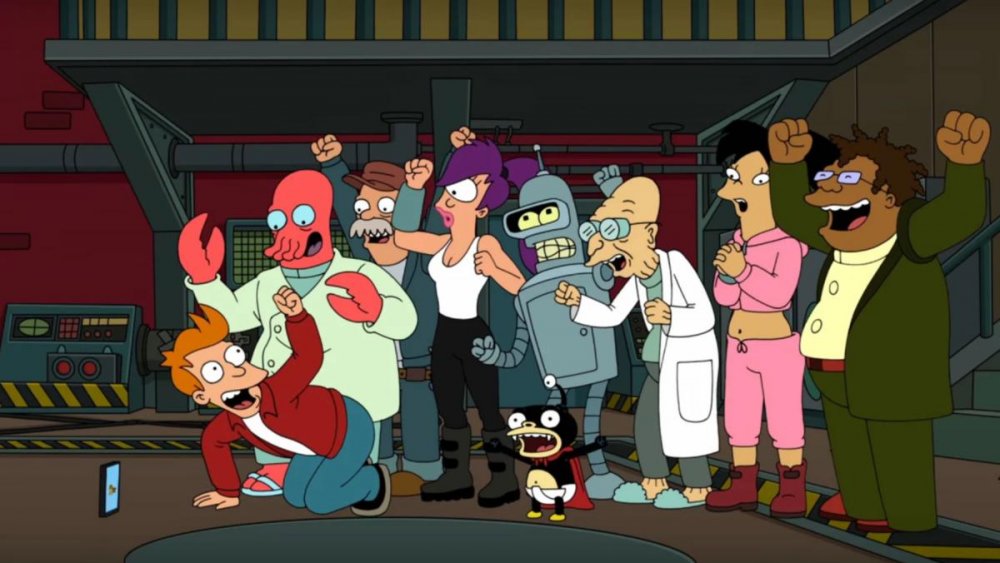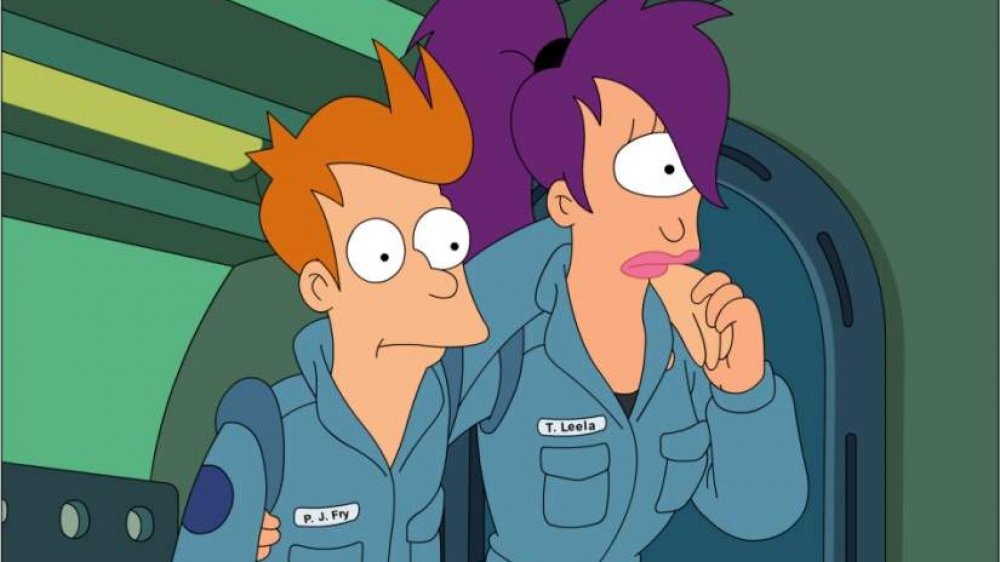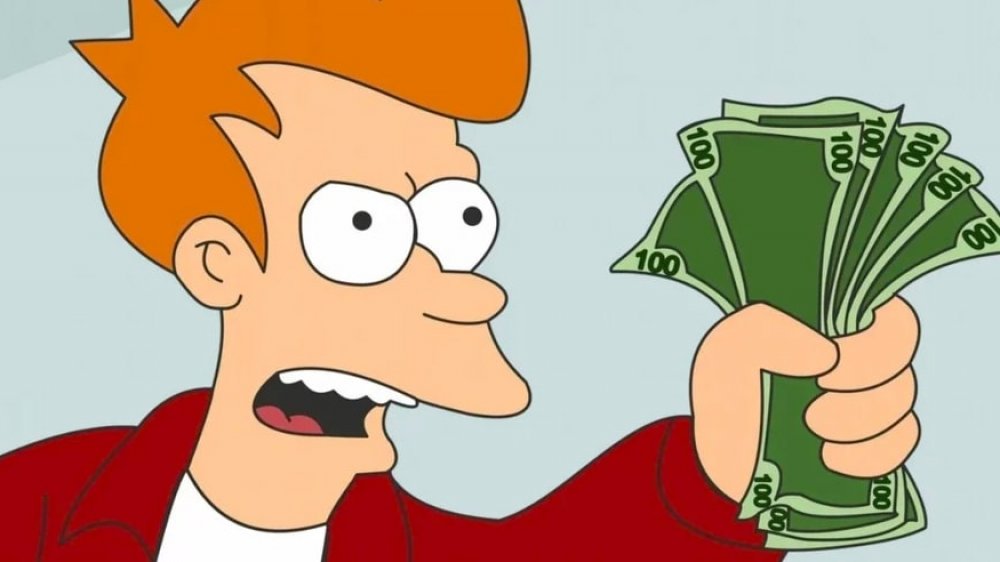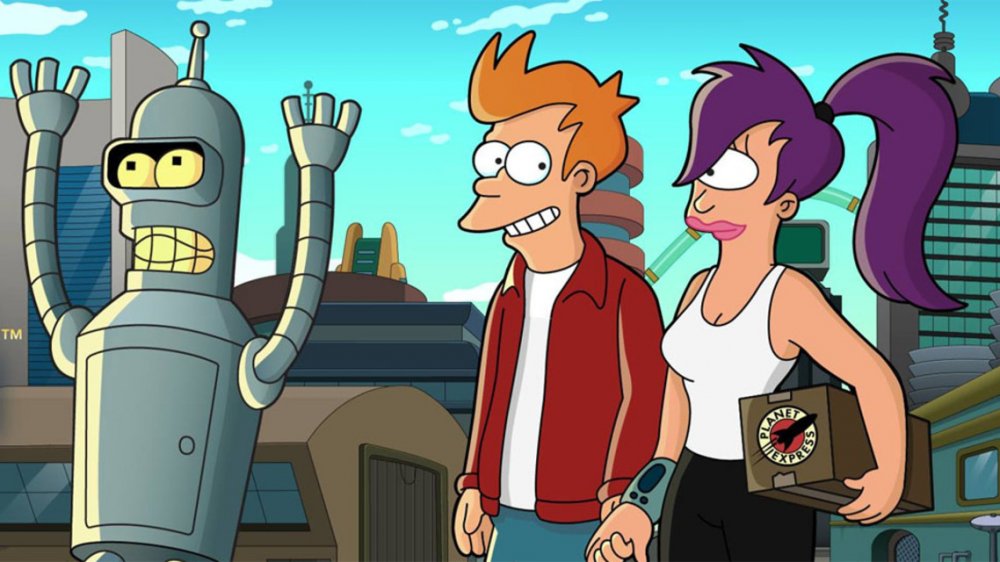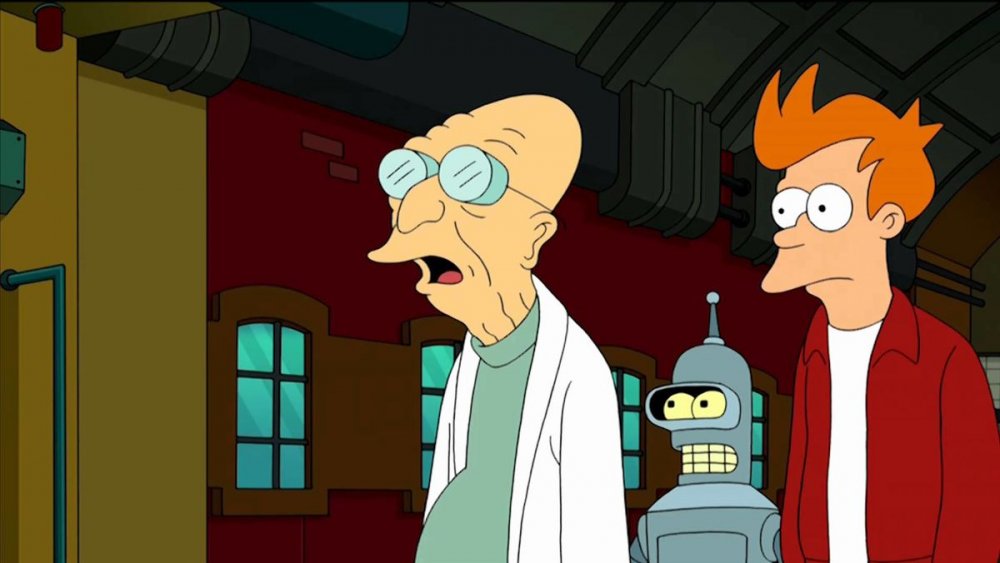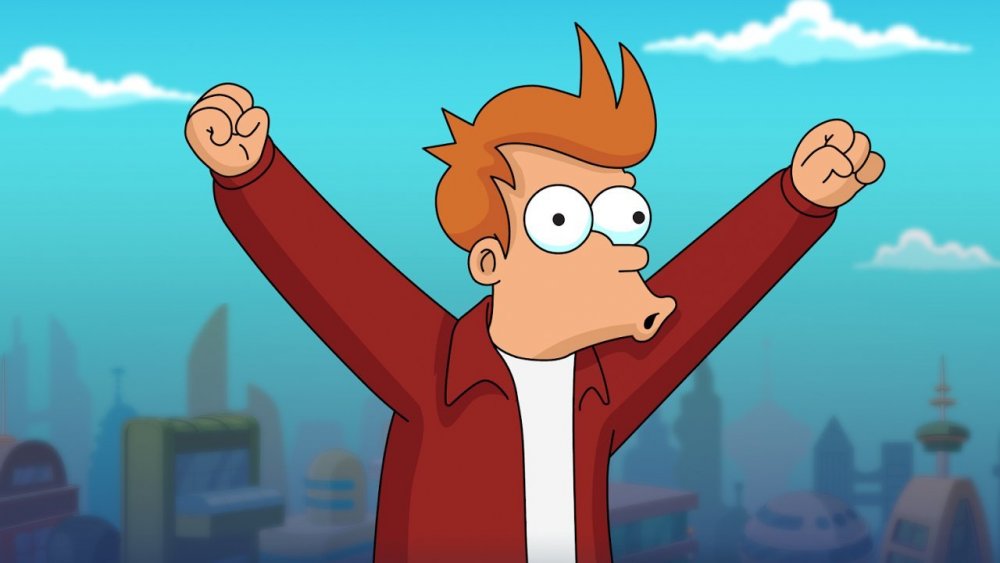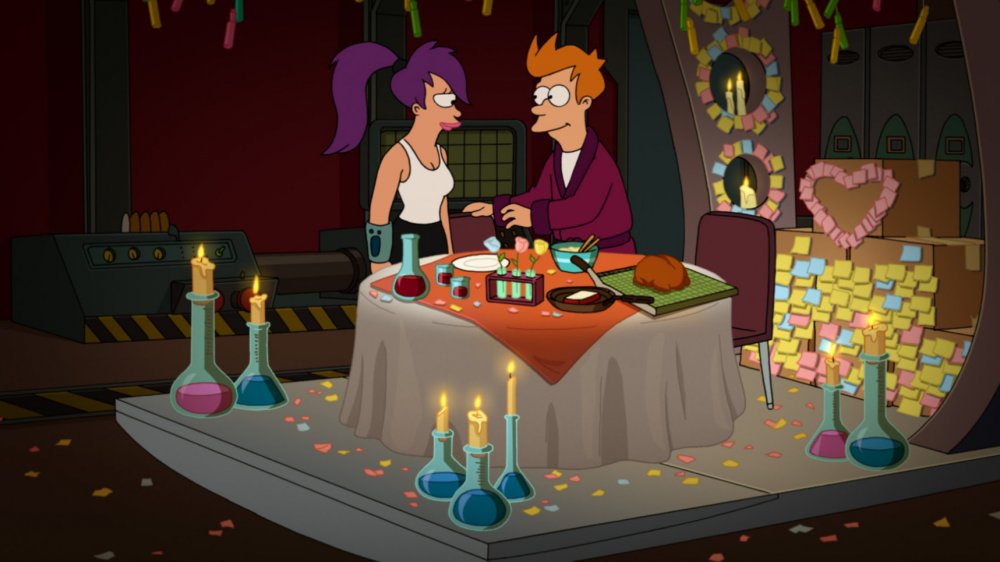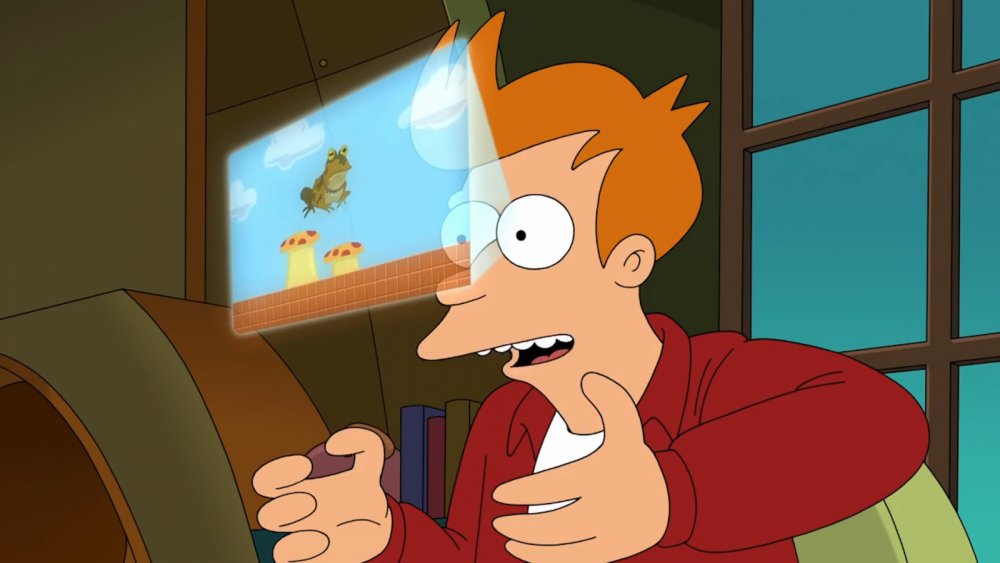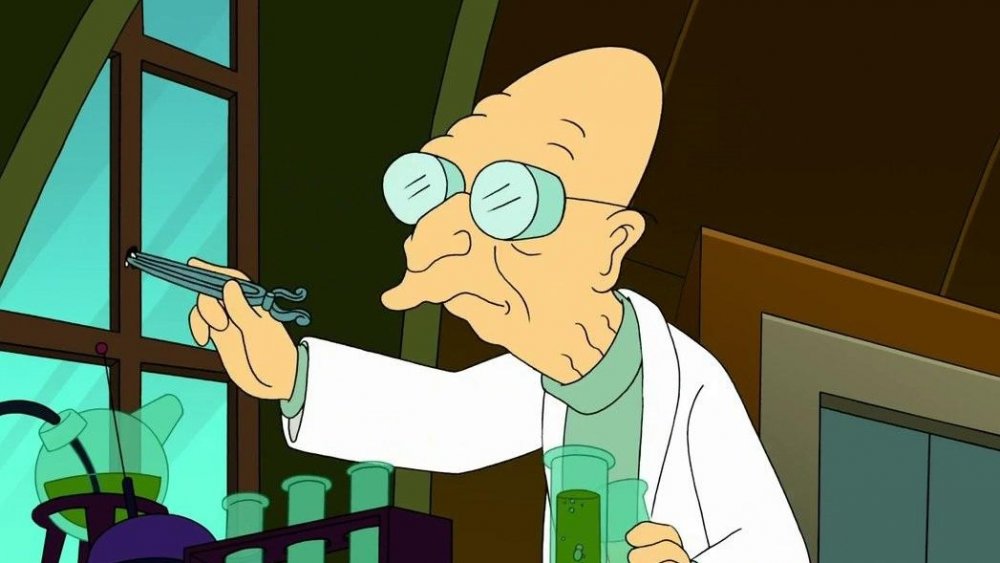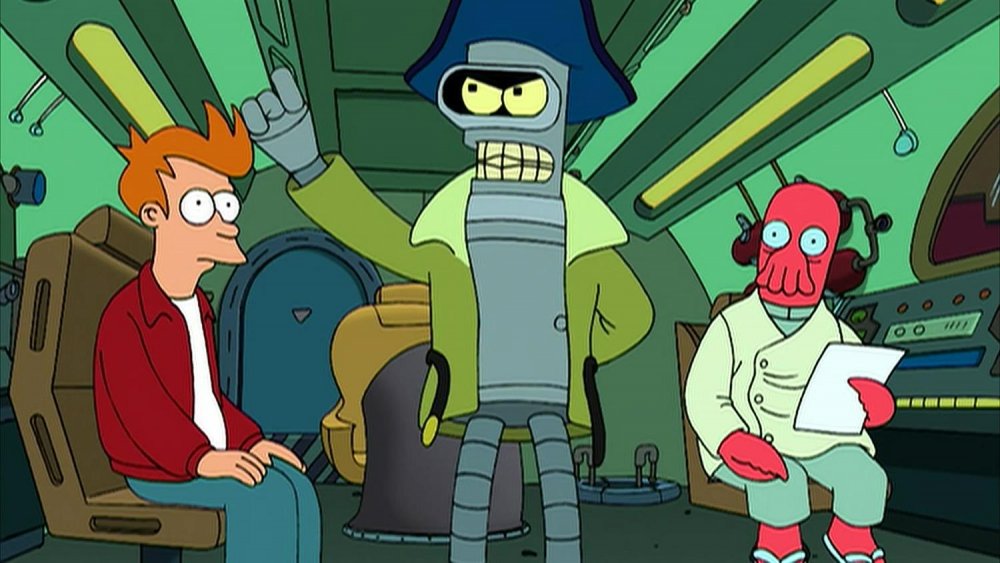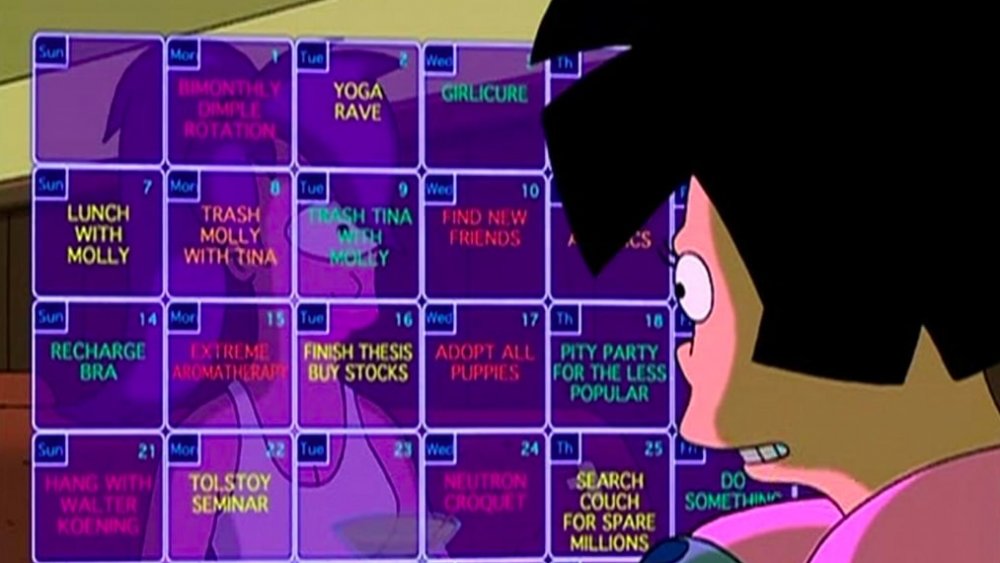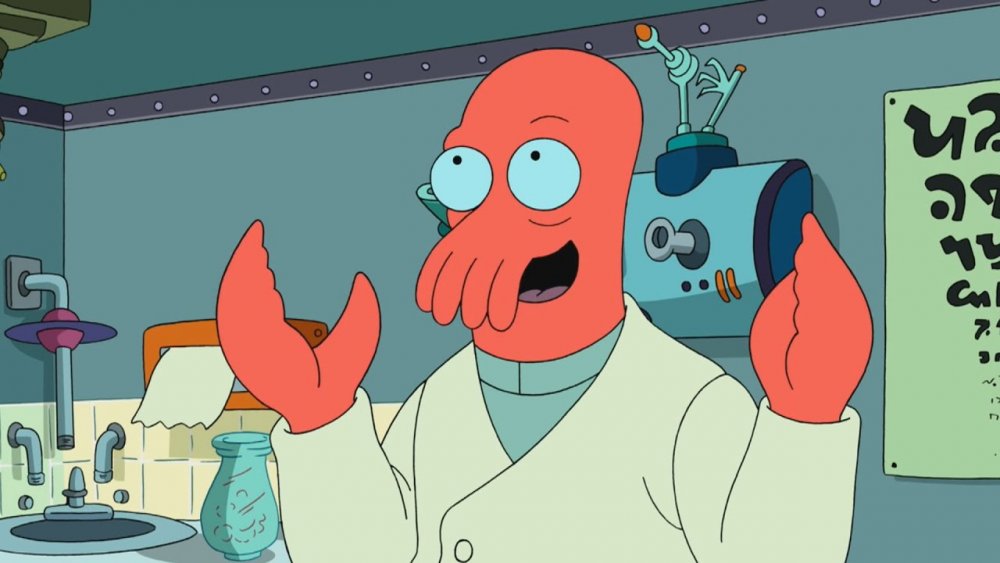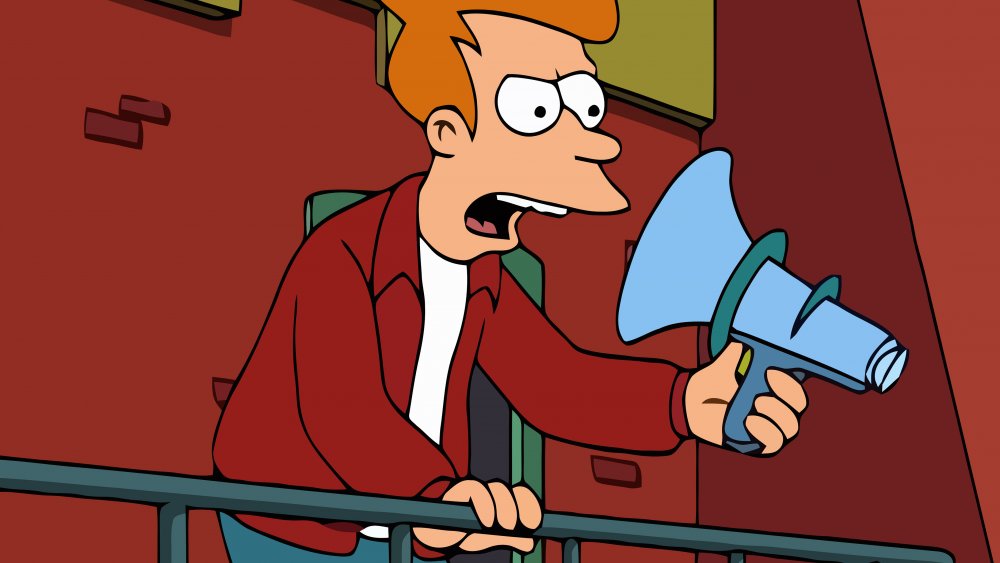How Futurama Changed Animated TV Without You Noticing
Just after midnight on January 1, 2000, a pizza delivery boy fell into a cryogenic pod and froze, waking up to a different world in 2999. Futurama, a sci-fi cartoon with a sense of humor, follows Fry as he adjusts to his reality in New New York, joins the crew of misfits on the Planet Express, and ends up in crazy situations across the universe. He's still the same immature pizza boy he was 1,000 years ago, but now he's got to learn how to get along in a whole new era.
After being canceled and brought back more than once, Futurama finally wrapped up for good in 2013. But the love for this show hasn't faded, and its influence can be seen in plenty of other shows today, animated or otherwise. Here's how a cartoon that the creators had to fight just to keep on air actually ended up changing TV.
Futurama's revival set a precedent for niche TV
Futurama became a fan favorite shortly after its premiere, but the higher-ups at Fox never saw it that way. That's partially because it wasn't produced for mass audiences. The creators always knew it would have its own specific niche.
"The people at Fox didn't ever support the show and it wasn't to their taste and, in my opinion, they're out of their minds," Groening said during a 2003 interview. He elaborated, "The idea of a TV show that they haven't gotten their greasy fingers all over creatively drives them nuts. We won the Emmy for animated show and I didn't even get a begrudging phone call from anyone at Fox." Groening always felt that the writers were finally given the creative license they really needed when Comedy Central picked up the show and ordered new episodes.
Today, it's not such a big deal if a show isn't the right fit for the network it premieres on, and Futurama proved that a good show could be revived on a new platform. For instance, the critically acclaimed sci-fi series The Expanse didn't stick around on SyFy after three seasons, because it found a new home on Amazon Prime, which gave the writers more room to experiment.
The internet boosted Futurama's fandom
Some shows seem to naturally attract the kind of fans who want to dissect every little detail of the plot and come up with tons of theories about where the season is going. Futurama definitely fell into that category — and it was no accident. When Groening and the rest of the team began working on the first episodes, they wanted to pack every episode with jokes and references that fans could discuss online.
"We've taken bits and pieces of all the conceptions of the future in the past 50 years and put them together in one wild show," Groening told Variety back in 1998, before the show had even premiered. "We've loaded it with the kinds of secret jokes and details that fans will spend hours on the Internet debating." The writing team was definitely forward-thinking in this regard.
Now, every showrunner knows that fans will be posting about new episodes as they premiere — especially since most people are binge-watching their favorite shows on their laptops and smartphones anyway. No matter what you're watching, there's an online fandom ready to discuss every aspect of the show.
Futurama aimed for older audiences
Futurama never attempted to be a family-friendly show. Sure, there had already been some network cartoons, like Groening's own The Simpsons, in which older viewers would certainly understand more of the jokes, while some lines would fly over younger viewer's heads. But Futurama was explicitly written with mature audiences in mind, and it wasn't the kind of show that you could watch with your kids. Yes, this naturally made it a harder sell, but it didn't necessarily need to be geared towards a mass audience to gain a large viewership — it was still a hit with older teenagers and adults.
Today, cartoons for adults are quite popular, and they are not confined to any one genre. The Boondocks explored topics like race and social issues, the black comedy F is for Family follows the life of a working-class family in the 1970s, and Archer tells the story of a dysfunctional secret agent and his colleagues. Each year brings new adult cartoons to our screens and favorite streaming platforms, and shows like Futurama made it clear that cartoons weren't just for kids anymore.
Futurama had a unique blend of sci-fi and comedy
Futurama could definitely be categorized as sci-fi. But unlike so much of the genre, it wasn't a drama, nor was it a suspenseful thriller — it never took itself too seriously. Every scene was packed with jokes, and most of the characters weren't particularly smart. They just happen to have access to all kinds of crazy, futuristic technology. Futurama was a comedy at heart — but it also explored various scientific developments that aren't possible (yet).
That's what made Futurama so special — it wasn't just a show for sci-fi enthusiasts. And it wasn't just a show for people who enjoyed comedy, either. There was plenty of crossover appeal. You didn't need to be a typical sci-fi fan to understand the jokes, and Futurama drew more people into this genre. Today, it's clear that there is plenty of overlap between fans of comedy and fans of sci-fi. Animated shows like Rick and Morty, which is often seen as a successor to Futurama in some ways, are popular because of the hilarious interactions between characters and the absurdly funny scenarios they find themselves in. While cartoons like Invader Zim appealed to a younger set, it crossed genres in a similar way.
CGI and traditional cartooning coexisted in Futurama
While the visual design was classic Groening and looked similar to The Simpsons, the animators behind Futurama also utilized different techniques, like incorporating CGI visuals, to create the cosmic settings. For example, the Planet Express ship has a distinct appearance because it is rendered in 3-D. When rendering the characters in 3-D, the animators would generally "dumb down" the image to prevent it from looking too realistic. They avoided photorealism and aimed to make 3-D images look hand-drawn. Using CGI for animated shows was not very common when Futurama premiered.
Animators working today have all kinds of tools that the team behind Futurama didn't have when the show began, and many animation teams rely heavily on CGI. The characters on Archer are rendered in 3-D and then edited to give the appearance of being hand-drawn. The animators working on Bob's Burgers draw everything digitally on tablets first, and then edit the images so that they look more like traditional animation.
Futurama had surprising emotional depth
Yes, Futurama was a comedy first, but it also had an emotional depth that animated TV shows often lack. Some of the best-known episodes of Futurama aren't remembered because of the interesting scientific concepts they introduced, but rather the way this cartoon managed to tug on your heartstrings. What Futurama fan could forget the episode where we find out that Fry's loyal dog, Seymour, spent years waiting outside the pizza place for Fry to return? Or the time when Fry made a deal with the actual (robot) devil to express his love for Leela with newfound holophonor skills?
It's easy to see how this has influenced popular animated shows today. In Rick and Morty, the family dynamics are just as important to the plot as Rick and Morty's crazy adventures across the galaxy. And this doesn't just apply to newer sci-fi shows, either. For example, BoJack Horseman, a black comedy that follows a washed-up celebrity as he attempts to return to relevance and has to deal with his inner demons, tackles issues like depression, addiction, trauma, and toxic relationships.
Responding to fan demand
The Futurama writing staff had to get used to writing series finales, because the show was canceled and brought back more than once. It was "canceled" for the first time in 2002 — but it turned out that this "cancellation" really just ended up being a long hiatus. Passionate fans pushed for the show to come back, and Futurama eventually found a new home on Comedy Central (who canceled and renewed it all over again).
Now, it's so much easier for fans to directly interact with the creators of their favorite shows — and sometimes, that does result in a particular show being brought back when it should have been canceled. After all, The Expanse was canceled after three seasons on SyFy, but fans hoped that their demand for a new season would result in a revival, and their instincts were correct. The sci-fi series Sense8 was initially canceled, but it was brought back for a two-hour finale. The success of Futurama after being revived proved that the network does not always know best. Sometimes, when the fans say that a show isn't ready to go, they're right!
Futurama was written by experts
It may have been a fictional show (and a pretty heightened cartoon at that), but most of the futuristic ideas in Futurama were grounded in real scientific principles. In fact, the creative team behind the show included several people with expertise in science and mathematics. Combined, the staff held seven master's degrees and three Ph.D.'s. Series writer Patric M. Verrone once referred to the writing staff as "easily the most overeducated cartoon writers in history."
Shows that explore similar concepts also employ incorporate actual science into the plot. For example, while The Big Bang Theory wasn't a sci-fi show, most of the main characters were scientists, and they were definitely major fans of all things sci-fi. The writers consulted with scientists to finalize scripts, because they knew that the fans would notice if their facts were off. And one cast member, Mayim Bialik, is actually a neuroscientist in real life! She also helped out with consulting on scripts every once in a while.
The sophisticated humor of Futurama
When Futurama premiered, cartoons geared towards adult audiences were few and far between in America (South Park's cable success notwithstanding). It was easy to assume that since cartoons were generally created for kids, the jokes would be simplistic and not exceptionally complex.
But with Futurama, this wasn't the case. "We were given the opportunity to push the envelope, but not in a desire to be dirty, but more complexity," said cast member Billy West. "There were jokes in Futurama that had more layers than an onion." You didn't have to be a genius to understand the humor in Futurama, but there were plenty of jokes that required some thought. For example, in the episode "Prisoner of Benda," the characters end up swapping brains, but they can't directly swap with each other again to get back in their own bodies. To solve this dilemma, the writers had to come up with a complicated mathematical formula, now known as the "Futurama theorem."
Today, fans of adult cartoons appreciate the complexity behind their favorite shows — just look at the convoluted timeline and parallel universes explored in Rick and Morty!
Futurama's "freeze-frame" jokes
The writers and animators who worked on Futurama did not waste any potential for humor, and they packed the background with blink-and-you'll-miss-'em jokes. "We could hide these jokes in the background that were called freeze-frame jokes, because early on it was the beginning of the VCR era," executive producer David X. Cohen told Wired. He explained, "If you make a lot of obscure jokes and references on a lot of different subjects in the background, then many of the viewers will have their glorious viewing moment where they'll say 'oh my God, I can't believe they put in that joke for me.'" From that moment on, viewers became permanent fans — they were genuinely in on the joke, and they felt that the writers understood their sense of humor.
The experience of watching a TV show today is completely different from the experience of watching a show when Futurama first hit the air, and since anyone can pause a show while streaming it, "freeze-frame" jokes are commonplace. If you watch closely and pause at the right time, you'll notice little details and Easter eggs everywhere, from the background of animated shows like BoJack Horseman and Adventure Time to live-action series like 30 Rock and Arrested Development.
Callbacks to previous episodes
With some TV shows, you can't just jump in and enjoy any given episode if you haven't seen the previous installments. There's a lot of lore to learn, there are continuous narrative threads, and each character has a specific backstory that informs much of the plot and their relationships. Others don't really demand that the viewer pay attention for the long-term — you can simply put on an episode and understand everything that's happening, even if you don't know anything about the show.
What made Futurama so special in this regard? The balance between the episodic and serialized plots. Anyone who happened to catch an episode of Futurama would end up laughing, even if they hadn't heard of the show before. But fans who had been watching for a while were also invested in certain plotlines that played out over the seasons, like seeing how Fry and Leela's relationship developed. Older TV shows were often developed to be episodic — this was better for reruns, and networks would often air episodes of TV shows out of order. But with the advent of streaming platforms and the age of prestige TV, serialized shows have gained popularity. Futurama demonstrated how a show could play with both formats.
What came next for the cast of Futurama?
Although Futurama officially ended a few years ago, some of the cast and crew went on to work on similar TV shows. For example, Groening's latest series, Disenchantment, is set in a completely different world from Futurama — the series follows Bean, an alcoholic princess with a rebellious streak, and her misadventures with her elf sidekick Elfo and her "personal demon," Luci.
Just as Futurama put a creative spin on sci-fi tropes, Disenchantment turns the fantasy genre on its head. And some of the cast members from Futurama have joined the cast. John DiMaggio, who voiced Bender, is now the voice of Bean's father, King Zog. Billy West, who voiced several characters on Futurama (including Fry, Professor Farnsworth, Dr. Zoidberg, and Zapp Brannigan), now voices a few minor characters on Disenchantment, including Sorcerio and the Jester. And Tress MacNeille, who also provided voices for multiple minor characters on Futurama, voices Queen Oona. Not only does the cast and crew of Futurama still love working together on new projects, they've made an impact on plenty of other shows, too.
